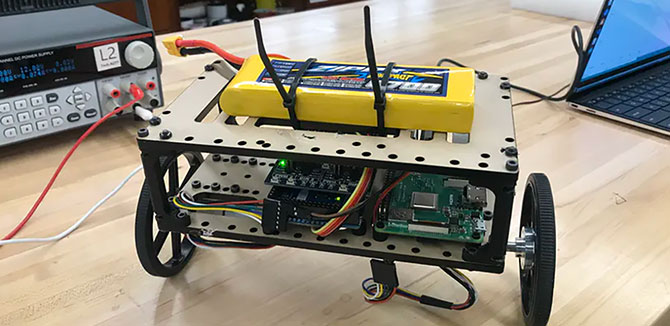Sir LanceBot Stays Upright
Current Master of Science in Robotics student Kojo Welbeck talked about building a self-balancing robot and what its success means for his future.
Kojo Welbeck created a self-balancing robot for his independent project in Northwestern Engineering's Master of Science in Robotics (MSR) program, but before he completed it, he wanted to give his robot a name.
Welbeck dubbed the platform-robot Sir [Ba]LanceBot.
LanceBot's goal was slightly less grand than those of his near-namesake from Knights of the Round Table lore. While Sir Lancelot rescued Queen Guinevere and launched a quest to find the Holy Grail, LanceBot's mission was simply to stay upright.
Lancelot ultimately failed, but LanceBot did not.
“The most exciting parts were the moments of validation throughout the process," Welbeck said. "There were many experiments and a lot of trial-and-error learning along the way. Ultimately, zeroing in on a good set of control parameters and seeing LanceBot hold its upright stance was the biggest win.”
A native of Ghana, Welbeck earned his bachelor’s degree in mechanical engineering from the Massachusetts Institute of Technology in 2014. He then worked as a mechanical design engineer at Compass Automation and a home automation engineer at startup Clearspace Labs before joining the MSR program.
He said he was inspired to build LanceBot after watching numerous videos of other self-balancing robots, from Ascento’s jumping balancer to James Brunton’s Sonic the Hedgehog.
“Balancing robots have long been a curiosity to me, and so I jumped at the chance to build one,” Welbeck said. “This project in particular checked off a number of motivations: something mechatronics in nature, something motorized, and a statically unstable system with multiple levels of control.”
Like most robotic creations, the road to success for LanceBot was paved with setbacks. Creating a two-wheeled mechanized device that’s able to stay upright and centered isn’t easy, Welbeck joked.
“There were a few sparks from mindlessly shorting battery terminals," Welbeck said, "many episodes of runaway out-of-control robots, and the odd hardware glitch here and there."
Welbeck succeeded in part because early on he realized his original goal for the project was too ambitious.
“I nixed much of the original intent in favor of a smaller robot footprint, lower number of degrees of freedom, and reduced power requirements,” Welbeck said
With something much more doable in the allotted time frame, Welbeck applied what he'd learned so far in MSR and did what innovators do – test, retest, and test some more. With each experiment, LanceBot morphed and evolved.
The addition of a few key features made that growth process a little easier.
“Adding a safety check function into my control loop was major, sparing me many hazardous incidents and potential breakages whenever the robot would topple over,” he said. “And it toppled over many times on its way towards finally balancing.”
Though his independent project is over, Welbeck’s quest with Sir LanceBot isn’t. He wants to continue testing and experimenting with the robot and different balancing control schemes. Ultimately, LanceBot didn't just succeed in standing up — it gave Welbeck new inspiration for the rest of his time in MSR.
"I have possibly become even more of a controls system enthusiast," Welbeck said, "and I look to continue building expertise around dynamic systems and control algorithms.”


